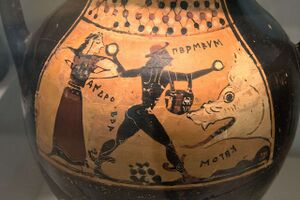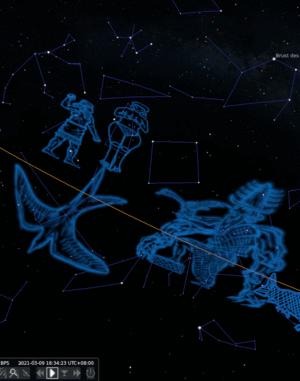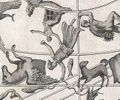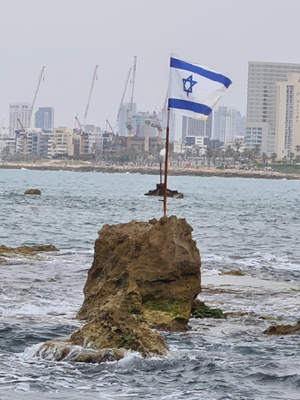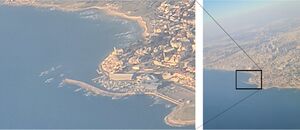Andromeda: Difference between revisions
IanRidpath (talk | contribs) m (→References: Edited web link) |
|||
| (2 intermediate revisions by one other user not shown) | |||
| Line 1: | Line 1: | ||
[[File:Corinthian amphora, Andromeda, Perseus, Cetus, 575-550 BC, Berlin F 1652, 141650.jpg|alt=Perseus defends Andromeda from the monster Cetus by pelting it with stones. Corinthian amphora, 575–550 BC|thumb|Perseus defends Andromeda from the monster Cetus by pelting it with stones. Corinthian amphora, 575–550 BC. Note that no rock is visible, only the stones which are thrown at the monster by Perseus (Antikensammlung Berlin, Altes Museum, F 1652, Zdenek Kratochvil). ]] |
[[File:Corinthian amphora, Andromeda, Perseus, Cetus, 575-550 BC, Berlin F 1652, 141650.jpg|alt=Perseus defends Andromeda from the monster Cetus by pelting it with stones. Corinthian amphora, 575–550 BC|thumb|Perseus defends Andromeda from the monster Cetus by pelting it with stones. Corinthian amphora, 575–550 BC. Note that no rock is visible, only the stones which are thrown at the monster by Perseus (Antikensammlung Berlin, Altes Museum, F 1652, Zdenek Kratochvil). ]] |
||
Andromeda is the daughter of Queen Kassiepeia (Latin: Cassiopeia) and King Kepheus (Cepheus) of Ethipia. Her mythology is described in all detail in [http://www.ianridpath.com/startales/andromeda.html Ian Ridpath's Star Tales]. It is assumed that |
Andromeda is the daughter of Queen Kassiepeia (Latin: Cassiopeia) and King Kepheus (Cepheus) of Ethipia. Her mythology is described in all detail in [http://www.ianridpath.com/startales/andromeda.html Ian Ridpath's Star Tales]. It is assumed that the actors are mythological figures without a historical counterpart. |
||
== Transfer and Transformation of the constellation == |
== Transfer and Transformation of the constellation == |
||
| Line 82: | Line 82: | ||
== References == |
== References == |
||
* Ian Ridpath, |
* Ian Ridpath, [http://www.ianridpath.com/startales/andromeda.html Star Tales, Online edition] |
||
* Strabo, Geography (1st century) |
* Strabo, Geography (1st century) |
||
* Josephus Flavius, Bellum Judaicum (1st century) |
* Josephus Flavius, Bellum Judaicum (1st century) |
||
| Line 91: | Line 91: | ||
[[Category:West Asian]] |
[[Category:West Asian]] |
||
[[Category:Eurasia]] |
[[Category:Eurasia]] |
||
[[Category:88 IAU-Constellations]] |
|||
Latest revision as of 10:24, 25 September 2024
Andromeda is the daughter of Queen Kassiepeia (Latin: Cassiopeia) and King Kepheus (Cepheus) of Ethipia. Her mythology is described in all detail in Ian Ridpath's Star Tales. It is assumed that the actors are mythological figures without a historical counterpart.
Transfer and Transformation of the constellation
The Greek legend of a princess sacrificed to a sea monster is know from two places: 1) Troy where the hero Hercules rescued the Troyan princess Hesione who was offered to the seamonster by her father, and 2) Jaffa (other spellings: Japho, Joppa, Yāfō and Yāfā) where the hero Perseus rescued the princess Andromeda. Hesione should pay for the sins of her father, Andromeda for those of her mother and both are considered to rescue their people with it. The kingdom in Anatolia where the Hesione myth stems from is said to have been established by Perseus which may imply a connection between the two tales.
In Babylonian time, the western part of the constellation was named "Anunītu" which is a by-name of the goddess of love and war, Ishtar. She was depicted next to her lover, the god of shepherds, Dumuzi, represented by the constellation of the Hired Man (Akkadian: Agru, mul lúḪUN.GÁ) as reported in MUL.APIN I i 42-43. Ishtar's attribute animal is the lion as they represent her on the famous city gate of Babylon, the Ishtar Gate (now: Vorderasiatisches Museum, Berlin).
Goddess of Ashkelon
In Ashkelon (40 km south of Tel Aviv), a special syncretism was worshipped: the Babylonian goddess of love was merged with the Egyptian goddess of love. The goddess of Ashkelon was strongly connected with fish as her attribute animal. Fish were holy for her and she is even occasionally depicted with a fish-tail. Thus, the northern one of the two fish of modern Pisces, was originally meant as an attribut of the goddess.
The Greek mythology of Andromeda originates from the area of Tel Aviv where a rock in the water used to be called "Andromeda's Rock" since at least Greco-Roman time. The story, of course, is much older, predates the written sources and similar mythologies existed in other areas (such as Troy, Anatolia, modern-day Turkey).
Other deities
Herodotus mentions that the cult of Ashkelon came through Cyprus to Greece. There she was named "Aphrodite Urania" (Ἀφροδίτη Οὐρανία) and got a temple in "the gardens" (ἐν κήποις) in Athens.
The Roman poet Ovid reports a story of the goddess of love, Aphrodite, escaping from the Giants with her son, Eros. When they arrived at the Euphrates, they jumped into the water and were rescued by two fish.
Ovid also reports a story of the birth of Aphrodite/ Venus from a huge egg that was rolled out of the Euphrates river by a fish. This creation myth of the goddess (invented in Roman time) contradicts the classical Greek creation myth where Aphrodite is born from hte foam of the sea. This traditional narrative gave her the name because Ἀφροδίτη derives from ἀφρός, aphrós, foam.
Princess of Ethiopia?
In ancient legends, Andromeda is described as the princess of Ethiopia without the location of this country being specified. The place of her sacrification, Andromeda's Rock, is at the coast of Tel Aviv (modern Israel) which is in contrast to the location of the modern country of Ethiopia in Africa. It lies east of southern Egypt (today’s Sudan) on the Red Sea. Although the ancient geographer Strabo also places Ethiopia in Africa, the Greek name of the ethnic group of the Αἰθίοψ (aithiops), “those with burned faces”, means the same as “dark-skinned person”. Ethiopia (Αἰθιοπία) is thus “the land of the dark-skinned” and, according to the Hellenistic worldview, this could be anything between India and Sudan. Strabo dates to Roman times (1st century BCE), so it is worth looking at archaeological historical research.
The Egyptian empire had previously (from c. 1550 BCE for about 4 centuries) not only encompassed the Sinai Peninsula, but also temporarily reached into the region of southwest Asia that is now Israel and Lebanon. The Jewish story of the Exodus (liberation from slavery by flight from Egypt, which is said to have taken place between 1200 and 1000 BCE) thus reports of exchanges (of people and culture) between Egypt and this fertile (flourishing) land. This is confirmed by historical research. Exchanges with the more eastern empires of Babylon and Assur can also be attested long before. Several generations of Egyptian pharaohs actually came from the area around Carthum (Sudan) in the 8th century BCE, the so-called “Black Pharaohs” and relations & exchanges between the milky coffee-coloured Berbers in the North African coastal region and the Blacks further south were of course always present – long before (in the 4th century BCE) light-skinned Macedonians conquered the land from Anatolia via the Levant to Egypt and called it “Greek”.
Leaving aside ancient Greek racism and “whitewashing” when Hellenism and Rome imagined that all peoples (even in Black Africa) were ruled by whites, all these changing state boundaries, rulers and migrations of peoples say nothing about the geographical location of the ethnic group of the Αἰθίοψ (aithiops).
Location according to ancient scholars
Herodotus (Greek historian, 5th century BCE) likes to play with words. For him Perseus is the progenitor of the Persians and Andromeda therefore also their progenitor [Hdt. 1:7]:
- When Perseus, the son of Danae and Zeus, came to Cepheus, the son of Belus, and married his daughter Andromeda, a son was born to him, whom he called Perses, and he left him there; for Cepheus had no male offspring; from this Perses the Persians have their name.
Herodotus was from what was then Persia, a place called Ἁλικαρνᾱσσός (Halikarnāssós, modern Bodrum in Turkey), which further places this pun in the realm of popular legends common at the time. One would thus conjecture that Cepheus and his grandson Perses ruled over a land located in present-day Turkey on the Mediterranean Sea.
Such folk etymologies are quite common in antiquity. However, no one seriously knows where the proper names used in this myth come from. Does the name “Andromeda” perhaps contain the verb δρομάς (to walk, to run), from which the name of the animal “dromedary” also derives – or the verb ἀνδρόω (to become a man)? What do the names “Cepheus” and “Cassiopeia” mean? No one knows.
Therefore, the linking of Perses and his father Perseus with the Persians seems to be rather invented after the fact.
References to Andromeda's Rock
Two historical reports are known in which the rock to which Andromeda was chained is geographically located: the geographer Strabo in the 1st century BCE and the Jewish-Roman chronicler Flavius Josephus in the 1st century CE both name Joppa (=Jaffa = historical old city of Tel Aviv), i.e. also the Mediterranean coast, but clearly south of Bodrum (Turkey).
Strabo (-1st century)
Strabo’s indication here is strange to misleading [Strabo, Geography, 2:16.2]:
[enumeration of cities.] Then Joppa, where the coast of Egypt, extending at first eastward, makes a notable bend to the north. According to some writers, Andromeda was exposed to the sea monster at this place. It is high enough and is said to offer a view of Jerusalem, the capital of the Jews….
Joppa and the coastal strip south of it (including Ashkalon and Gaza) actually belonged to Egypt at the time, but I doubt you can see Jerusalem from there because 1) Jerusalem is 750 m higher than Tel Aviv and 2) there is a mountain in between. Nevertheless, the proximity of Jaffa and Jerusalem is remarkable when one looks at the legend of Andromeda, because – like the most famous of all Jewish prophets, who was later executed by Romans in Jerusalem – Andromeda is also guiltlessly sacrificed by her people for the sins of others (esp. her mother). This kind of belief in a human redeemer from the sins (of the people) is thus demonstrably not uncommon in this geographical area.
Josephus Flavius (+1st century)
Josephus is a Jew who at first wanted to defend Jerusalem, but later joined the Roman conquerors and therefore took the name of the emperor Flavius. After going to Rome, he wrote a chronicle of the Jewish-Roman war (in which the famous Second Jerusalem Temple was destroyed). So Josephus, writing after 70 CE, will have reported that he still saw the chains of Andromeda on the rock (or at least remains of them), [Flavius Josephus 1:3.419]:
Joppa, however, is not by nature a harbour, for it ends on a rough shore, while everything else is straight, but the two ends bend towards each other, where there are deep chasms and great stones jutting into the sea, and where the chains with which Andromeda was bound have left their traces, which bear witness to the antiquity of this fable.
However, he also tells of “deep chasms and great stones” and this is indeed the image on the coast of the historic old city of Tel Aviv.
The Andromeda Rock, photographed here seaward against the skyline of the modern district (Tel Aviv, Bauhaus style), is marked with an Israeli flag. This modern city was built after the world wars and borders directly north on the historic old city (Joppa=Jaffa), so that the official name of the metropolis is now Tel Aviv-Jaffa. First the Philistine people settled there, later the area was conquered by the Egyptians and still later by the Romans.
For those who do not believe what Josephus describes from the above photos or with the knowledge of the tourist beach promenade of Tel Aviv, this aerial photo (which I took with my mobile phone when I left) may seem a more credible proof: there are really no large rocks far and wide on the coast of today’s Tel Aviv, but plenty of “menhirs in the water”, if one may say so somewhat casually.
So if Andromeda was chained to a rock here, it certainly didn’t look like she was depicted in early modern paintings (screenshot from wikipedia below) with her arms raised upwards, because there would have been no rock for that – apart from the fact that ancient depictions don’t show her naked, but always clothed (vases: heroes naked, ladies clothed, ancient celestial globes).
None of the rocks is taller than a human being. Possible would be a pose as painted by Guido Reni in the 17th century or as erotically draped in sculptural art by Daniel Chester French in 1931. In any case, the Andromeda saga is virtually the ancient version of Fifty Shades of Grey.
No surprise that the story and depiction of Andromeda has been controversial for centuries! It is sexist, frivolous, depicts clear patriarchal gender roles, is suspected of ancient racism, which would be called “whitewashing” in modern times… Indeed: the skin colour of Andromeda has also long been the subject of controversy: Ovid (living in Roman times and restaging many ancient sagas by combining narrative strands from different cultures of the empire) describes her sometimes marble-coloured and sometimes dark-skinned, while images on Greek vases show a fair-skinned figure at all times (since 600 BCE). The wikipedia reports on this in detail.
When did the story take place (if at all)?
No one is able to prove the historicity of this story, but Ernst Künzl pointed out in an article on the origin of the star sagas that all “Greek” constellation sagas take place in the time before the Trojan War. Earliest Greek-language texts are attributed to an author named Homer, of whom it is not known whether it was really just one person (or denotes a group), because the word “homer” actually means exactly “host”, so it can also denote one or more person(s) from another culture (e.g. Babylonian) who wrote in Greek. This person or group of people is dated to about 800 (give or take centuries) BCE.
Ancient historians tried to date the legendary Trojan War already in classical times and got dates before 1000 BCE, maybe 1200 BCE…. but these dates were derived half a millennium to a millennium later. If they are right, that would be exactly the time in which the exodus of the Israelites from Egypt guided by Moses is supposed to have taken place – with an equally vague dating.
The Andromeda story would therefore have to have taken place (if at all) when this land had not yet been settled by the Israelites or at the latest at the time of their arrival. All sources in the form of images and writing date many centuries later and could already paint the picture mythically transfigured (not truthfully).
So where does Andromeda come from?
… from Africa (today’s Eritrea/Ethiopia), from the (today’s) Turkish coast or from the (today’s) Israeli coast? The answer is probably not clear. The tendency is probably more from West Asia than Africa.
The beliefs (of patriarchal societies in nomadic peoples, the equal worship of 4 matriarchs and 3 patriarchs in the Jewish faith, the innocent human sacrifice for the redemption of sins in the Christian etc.) are present in this region and also the story of the sea monster Ketos seems to originate rather from there, i.e. here too (AFAIK) literary research sees the origin in various source stories in the eastern Mediterranean region: the myth of Heracles and Hesione is said to have come from Anatolia, whereby Heracles rescues the princess Hesione but (in most variants) does not marry her (but gives her to a follower as a bride or enslaves her). From the Levant there is the above-mentioned erotic Andromeda story, from which the “Persians” in Anatolia are said to have descended. Both deal with a sea monster and a lady who (as an idle figure) is saved from it by a hero.
However, the constellation of Andromeda is also located at the place where the Babylonian goddess of erotic love has her constellation. Therefore, the suspicion is that the Greek figure of Andromeda is a synchretism: a fusion of (i) the Babylonian erotic goddess (possibly mixed with the “goddess of Ashkelon”, who was also a love goddess), (ii) the sex idol from the Levant who was sacrificed for the sins of her mother and (iii) Hesione from Anatolia, who was sacrificed by her father for his sins.
References
- Ian Ridpath, Star Tales, Online edition
- Strabo, Geography (1st century)
- Josephus Flavius, Bellum Judaicum (1st century)
